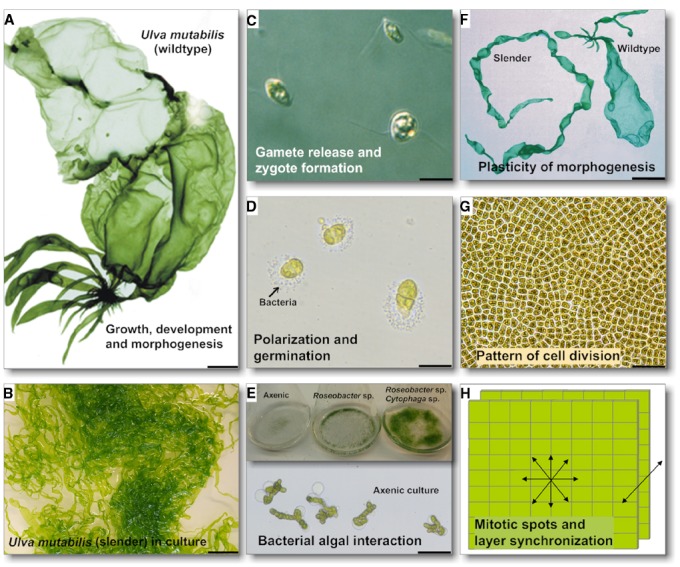FIGURE 2.

Characteristics of Ulva, and scientific contributions to research into Ulva growth, development and morphogenesis. Key events in Ulva ontogenesis are highlighted: (A,B) The wildtype U. mutabilis and a typical culture of its developmental mutant slender are shown (scale bar = 1 cm). Regulation of gametogenesis/zoosporogenesis, gamete/zoospore release and zygote formation are important checkpoints in the isomorphic, haplodiplontic Ulva life cycle. The wildtype (A) released gametes (C, scale bar = 5 μm) upon synchronous sporulation in the apical part of the thallus (= discharged colorless gametangia). (D) Unmated gametes propagate as a haploid strain and germinate with a clear polarization for primary rhizoid formation upon settlement, where bacteria that accumulate can be observed (biofilm formation). (E) Under axenic conditions Ulva develops into a callus with no cell differentiation and slow growth (1 week old culture; scale bar = 50 μm). However, morphogenesis can be recovered by a combination of two essential bacteria releasing morphogenetic compounds into the growth medium (3 weeks old culture). (F) Several U. mutabilis developmental mutants have been found: the fast-growing developmental mutant slender shows only traces of the sea lettuce like morphotype of the wildtype (scale bar = 1 cm). (G,H) It is hypothesized that mitotic spots spread over the thallus cause potential irregular extensions of the blade sheet, and that bilayer formation is regulated. These key questions must be addressed in future studies (scale bar in G = 50 μm). Images of U. mutabilis (A) and of gametes (C) were reprinted from Wichard and Oertel (2010) with permission from John Wiley and Sons, Copyright © (2010) Wiley. Image of the Ulva thallus (G) is a courtesy of Dr. D. Saint-Marcoux (University of Oxford, UK).
